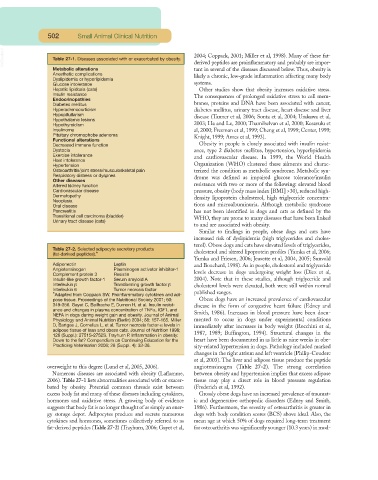Page 486 - Small Animal Clinical Nutrition 5th Edition
P. 486
502 Small Animal Clinical Nutrition
VetBooks.ir Table 27-1. Diseases associated with or exacerbated by obesity. 2004; Coppack, 2001; Miller et al, 1998). Many of these fat-
derived peptides are proinflammatory and probably are impor-
Metabolic alterations tant in several of the diseases discussed below. Thus, obesity is
Anesthetic complications likely a chronic, low-grade inflammation affecting many body
Dyslipidemia or hyperlipidemia
Glucose intolerance systems.
Hepatic lipidosis (cats) Other studies show that obesity increases oxidative stress.
Insulin resistance The consequences of prolonged oxidative stress to cell mem-
Endocrinopathies
Diabetes mellitus branes, proteins and DNA have been associated with cancer,
Hyperadrenocorticism diabetes mellitus, urinary tract disease, heart disease and liver
Hypopituitarism disease (Tanner et al, 2006; Sonta et al, 2004; Urakawa et al,
Hypothalamic lesions
Hypothyroidism 2003; Ha and Le, 2000; Thamilselvan et al, 2000; Kesavulu et
Insulinoma al, 2000; Freeman et al, 1999; Cheng et al, 1999; Center, 1999;
Pituitary chromophobe adenoma Knight, 1999; Ames et al, 1993).
Functional alterations
Decreased immune function Obesity in people is closely associated with insulin resist-
Dystocia ance, type 2 diabetes mellitus, hypertension, hyperlipidemia
Exercise intolerance and cardiovascular disease. In 1999, the World Health
Heat intolerance
Hypertension Organization (WHO) clustered these ailments and charac-
Osteoarthritis/joint stress/musculoskeletal pain terized the condition as metabolic syndrome. Metabolic syn-
Respiratory distress or dyspnea drome was defined as impaired glucose tolerance/insulin
Other diseases
Altered kidney function resistance with two or more of the following: elevated blood
Cardiovascular disease pressure, obesity (body mass index [BMI] >30), reduced high-
Dermatopathy density lipoprotein cholesterol, high triglyceride concentra-
Neoplasia
Oral disease tions and microalbuminuria. Although metabolic syndrome
Pancreatitis has not been identified in dogs and cats as defined by the
Transitional cell carcinoma (bladder) WHO, they are prone to many diseases that have been linked
Urinary tract disease (cats)
to and are associated with obesity.
Similar to findings in people, obese dogs and cats have
increased risk of dyslipidemia (high triglycerides and choles-
terol). Obese dogs and cats have elevated levels of triglycerides,
Table 27-2. Selected adipocyte secretory products
(fat-derived peptides).* cholesterol and altered lipoprotein profiles (Yamka et al, 2006;
Yamka and Friesen, 2006; Jeusette et al, 2004, 2005; Sunvold
Adiponectin Leptin and Bouchard, 1998). As in people, cholesterol and triglyceride
Angiotensinogen Plasminogen activator inhibitor-1
Complement protein 3 Resistin levels decrease in dogs undergoing weight loss (Diez et al,
Insulin-like growth factor-1 Serum amyloid A 2004). Note that in these studies, although triglyceride and
Interleukin β Transforming growth factor β cholesterol levels were elevated, both were still within normal
Interleukin 6 Tumor necrosis factor
*Adapted from Coppack SW. Proinflammatory cytokines and adi- published ranges.
pose tissue. Proceedings of the Nutritional Society 2001; 60: Obese dogs have an increased prevalence of cardiovascular
349-356. Gayet C, Bailhache E, Dumon H, et al. Insulin resist- disease in the form of congestive heart failure (Edney and
ance and changes in plasma concentration of TNFα, IGF1, and
NEFA in dogs during weight gain and obesity. Journal of Animal Smith, 1986). Increases in blood pressure have been docu-
Physiology and Animal Nutrition (Berlin) 2004; 88: 157-165. Miller mented to occur in dogs under experimental conditions
D, Bartges J, Cornelius L, et al. Tumor necrosis factor-α levels in immediately after increases in body weight (Rocchini et al,
adipose tissue of lean and obese cats. Journal of Nutrition 1998;
128 (Suppl.): 2751S-2752S. Trayhurn P. Inflammation in obesity: 1987, 1989; Buffington, 1994). Structural changes in the
Down to the fat? Compendium on Continuing Education for the heart have been documented in as little as nine weeks in obe-
Practicing Veterinarian 2006; 28 (Suppl. 4): 33-36. sity-related hypertension in dogs. Pathology included marked
changes in the right atrium and left ventricle (Philip-Couderc
et al, 2003). The liver and adipose tissue produce the peptide
overweight to this degree (Lund et al, 2005, 2006). angiotensinogen (Table 27-2). The strong correlation
Numerous diseases are associated with obesity (Laflamme, between obesity and hypertension implies that excess adipose
2006). Table 27-1 lists abnormalities associated with or exacer- tissue may play a direct role in blood pressure regulation
bated by obesity. Potential common threads exist between (Frederich et al, 1992).
excess body fat and many of these diseases including cytokines, Grossly obese dogs have an increased prevalence of traumat-
hormones and oxidative stress. A growing body of evidence ic and degenerative orthopedic disorders (Edney and Smith,
suggests that body fat is no longer thought of as simply an ener- 1986). Furthermore, the severity of osteoarthritis is greater in
gy storage depot. Adipocytes produce and secrete numerous dogs with body condition scores (BCS) above ideal. Also, the
cytokines and hormones, sometimes collectively referred to as mean age at which 50% of dogs required long-term treatment
fat-derived peptides (Table 27-2) (Trayhurn, 2006; Gayet et al, for osteoarthritis was significantly younger (10.3 years) in mod-

